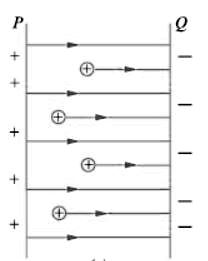The Equations of Poisson and Laplace
The Equations of Poisson and Laplace
These equations are useful in the solution of many problems concerning electrostatics especially the problem of space charge present in an electronic valve. The two equations can be derived by applying Gauss’s theorem. Consider the electric field set up between two charged plates P and Q [Figure given below]. Suppose there is some electric charge present in the space between the two plates. It is, generally, known as the space charge. Let the space charge density be ρ coulomb/metre3. It will be assumed that the space charge density varies from one point of space to the another but is uniform throughout any thin layer taken parallel to the plates P and Q. If X-axis is taken perpendicular to the plates, then ρ is assumed to depend on the value of x. It will be seen from Figure (given below) that the value of electric intensity E increases with x because of the space charge.


Now, consider a thin volume element of cross-section A and thickness Δ x as shown in Figure given below. The values of electric intensity at the two opposite faces of this element are E and (E + Δ E). If dE/dx represents the rate of increases of electric intensity with distance, then
![]()
The surface integral of electric intensity over the right-hand face of this element is

The surface integral over the left-hand face of the element is = − E × A
The negative sign represents the fact that E is directed inwards over this face.
The surface integral over the entire surface, i.e., the closed surface of the element is

From symmetry it is evident that along with y and z there is no field.
Now, according to Gauss’s theorem, the surface integral of electric intensity over a closed surface is equal to 1/ε0 time the charge within that surface.
Volume of the element, dV = A × Δ x; charge = ρ A . Δ x


It is known as Poisson’s equation in one dimension where potential varies with x.
When V varies with x, y and z, then

in vector notation.
If, as a special case, where space charge density is zero, then obviously,
∂2 V/∂ x2 = 0
In general, we have ![]()
in vector notation where ∇2 is defined (in cartesian co-ordinates) as the operation

It is known as Laplace’s equation
What is Poisson equation explain?
Poisson’s equation is an elliptic partial differential equation of broad utility in theoretical physics. For example, the solution to Poisson’s equation is the potential field caused by a given electric charge or mass density distribution; with the potential field known, one can then calculate electrostatic or gravitational (force) field. It is a generalization of Laplace’s equation, which is also frequently seen in physics. The equation is named after French mathematician and physicist Siméon Denis Poisson.
Read article – Units of Resistivity
Visit NCERTplanet.com for NCERT solutions and Textbook downloads




